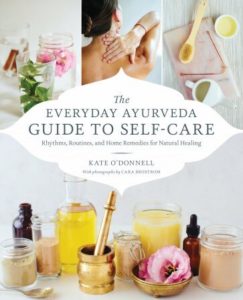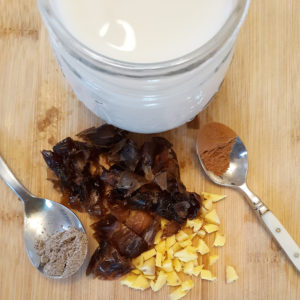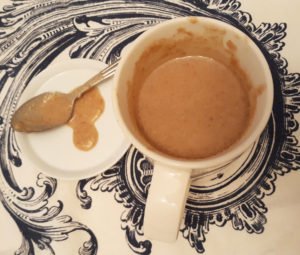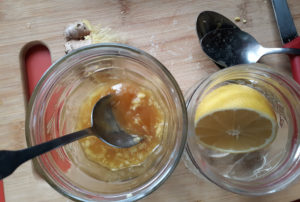 The Everyday Ayurveda Guide to Self-Care: Rhythms, Routines and Home Remedies for Self-Healing by Kate O’Donnell, 2020. Published by Shambhala Publications, Boulder. 288 pages with color illustrations.
The Everyday Ayurveda Guide to Self-Care: Rhythms, Routines and Home Remedies for Self-Healing by Kate O’Donnell, 2020. Published by Shambhala Publications, Boulder. 288 pages with color illustrations.
Recipes for Self-Care from Ayurveda
It’s four o’clock in the afternoon, and I’m deep into measuring and grinding spices, herbs and dates. Combined with almond milk (instead of cow’s milk since I’m vegan) this recipe makes a slightly warming smoothie blend. Recipes for self-Care from Kate O’Donnell’s new book, The Everyday Ayurveda Guide to Self-Care are simple and very do-able now. Today I’m making the one called Bone Builder.
Recipes offer luscious scent?
While preparing the recipe for Bone Builder, I noticed a delicious-smelling, vanilla/honey-like aroma when dates and almond milk are mixed together. According to Kate, the combination of dates, ashwaganda, and cardamom promotes healthy bones and slows aging.
 Helpful for any age, from teenagers to the more seasoned, the slightly caramel-colored Bone Builder is a lusciously scented snack or light dessert.
Helpful for any age, from teenagers to the more seasoned, the slightly caramel-colored Bone Builder is a lusciously scented snack or light dessert.
And that’s part of the secret of utilizing Ayurvedic concepts: your senses should guide you to healthier choices. After all, taste is a function of your senses that includes smell, as well as the senses of touch and sight.
 Your health isn’t a one-size fits all objective. Did you know for example that the exaggerated qualities of a season—say, winter, now turning into early spring—can be tamed in your body using simple measures? From easy to make at home remedies for clarifying, digestion-strengthening, cooling, beautifying and immune-fortifying… to concerns like digestion… immunity from colds and flus… The Everyday Guide to Self-Care has got you covered.
Your health isn’t a one-size fits all objective. Did you know for example that the exaggerated qualities of a season—say, winter, now turning into early spring—can be tamed in your body using simple measures? From easy to make at home remedies for clarifying, digestion-strengthening, cooling, beautifying and immune-fortifying… to concerns like digestion… immunity from colds and flus… The Everyday Guide to Self-Care has got you covered.
Yet Kate O’Donnell’s text is engaging on the level of spirit as well as bodily needs and requirements.
Without turning you into an advocate for alternative lifestyle, Kate’s book tells why it’s important to know yourself, your specific qualities and leanings, your abilities and goals. Kate’s mission is to help you uncover the mystery of chronic bloating after meals, why you lack energy to realize daily goals, or any number of other roadblocks to your success as a human being.
What’s in Ayurveda Self-Care for Me?
The Everyday Ayurveda Guide to Self-Care offers information on the Ayurvedic science of how the body works. Just as its easy to picture perfect health, it’s important to recognize the ways your health can veer off the rails. Kate’s intent is to guide you through the process of examining your day, how you pick up habits, and which habits could be more healthful.
In fact, the first quarter of the book is devoted to the category of knowledge in the Vedas known as Ayurveda. This is followed by instruction in self-care routines. And the last section of the book is a catalog of do-it-yourself remedies, recipes that are unique but easy to follow.
What are DIY Ayurvedic remedies?
Bone Builder and Ginger-Lemon Nectar—two of my favorite recipes are pictured in this post! They’re unexpectedly powerful, and I can sense a difference in energy after eating and drinking recipes made this way. As Kate indicates, “The best information is the kind you gain through your own experiments”, p. 132 and I concur. I can easily tweak a recipe’s ingredients to what I have on hand.
In Ayurveda, the human constitution is affected by the seasons in both obvious and peculiar ways. Right now, in winter weather, there are specific things you should be aware of, rather than controlled by: coldness and dryness being two of them. As winter turns into early spring, it’s more an abundance of moisture—read dampness—that’s prevalent.
For example, I could spin my food choices in favor of balancing vata, a dosha. The dosha of movement, vata has qualities of coldness and dryness and frequently goes out of control in winter. So, to balance vata, I should avoid eating drying foods and concentrate on unctuous and nourishing flavors.
And I would benefit from harnessing the advantages of daylight for the life-affirming energy it gives us. Arising before sunrise and be mindful of seasonal changes are two basic ways to observe “dinacharya” or daily routines that support vitality and health, for all doshas.
So, Swastha is … ?

I must say that reading The Everyday Ayurveda Guide to Self-Care has me inspired to take better care of myself! And I thought I was so cool, being vegetarian and all. Turns out that eating vegetables is a nominal commitment—I could do so much more to achieve swastha!
Ayurvedic science may take years to fully grasp and yet in The Everyday Ayurveda Guide to Self-Care, helpful indications about our habits, tendencies and appetites are offered for our use. My impression is that this book is written for beginners, albeit quite sophisticated ones. Its concepts are spelled out in plain language—Kate’s style is genuine and you’ll hear her experienced voice in each recommendation she makes. However, with the tone of writing aside, I think the book has value for the more advanced reader, too. In fact, the longer you’ve been on a path of self-healing the more sense you’ll be able to make of a lifestyle based in Ayurveda principles as described here.
Knowing that few books on the foundations of Ayurvedic beauty are available here, I was drawn to Kate O’Donnell’s newest book by the beauty recipes suggested in the cover photo. While real beauty results from self-care practices, once you become familiar with ways of developing a positive attitude towards the body, your innate attractive qualities will shine through. To care for and thus develop what you have is a great gift and at the heart of Ayurvedic philosophy.
In fact, descriptive words for ill-health or disease are found in quality of derangement, such as “heavy”, or “damp”, or just the word “vikruti”, as in vata vikruti, or imbalance. While your Ayurvedic practitioner may be able to explain these in terms of common ailments, in the book there’s no index for pain, stomachache, headache, etc. So, you wouldn’t want to use this book in case of acute distress.
The Everyday Guide to Self-Care has taken a complex subject and made it accessible, at least the parts of it we could use in our everyday lives. Its aim is to support what we know about ourselves by increasing our awareness through the science that helps us to really know our selves.



